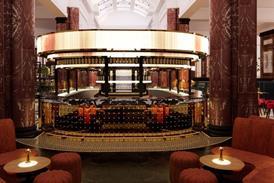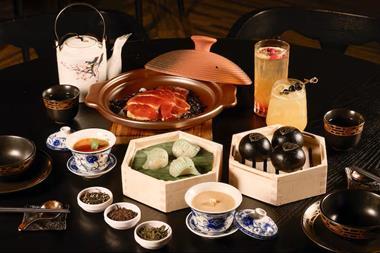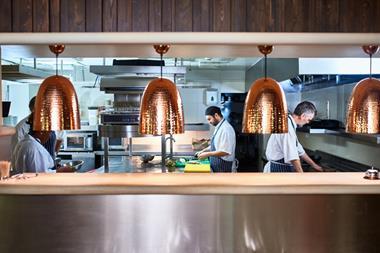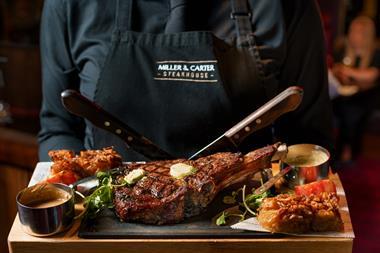Alan Yau, the founder of Wagamama, Busaba Eathai and Hakkasan, discusses how the UK restaurant sector latched onto the theme of seasonality and compares the comparisons and differences between the British and Japanese dining scenes.
It’s often said that Britain and Japan share a lot of common characteristics: both are island nations with an Imperial past, and their citizens have a reputation for being both polite and reserved; more topically, political uneasiness has become the overwhelming factor in their respective relationships with geographical neighbours, albeit for very different reasons.
When it comes to cuisine, the comparisons appear to break down, though there is one aspect that cannot be ignored: the British and the Japanese adhere to a rhythm of life that is driven by the seasons. But whilst the notion of ‘seasonality’ was embraced by UK chefs only in recent years (together with ‘provenance’, as a counterpoint to the all-pervasive force of globalisation), the Japanese have celebrated ‘shun’ since time immemorial: it is absolutely fundamental to their culinary ethos as evidenced in formal ‘kaiseki’ cuisine, with the seasonality of ingredients dictating not only the actual dishes but also how they are presented at an aesthetic level – during cherry blossom season for example, you will see the same sakura motif time and time again in both the mise en place as well as the crockery.
The interesting thing about seasonality in a restaurant context is its inherent transience, which is fundamentally contrary to an immutable cardinal law for the restaurateur: that consistency is king. Whenever I dine out at my favourite restaurants, the specials do not interest me as much as the tried and tested dishes: the chances are, the chef is just playing around with some fancy seasonal ingredient that he doesn’t really know how to cook properly. In Japan, it’s obviously different but then again, the majority of the best chefs there focus on a singular speciality cuisine that they have perfected over many years.
I once had a casual conversation about this with a design aficionado friend of mine, who retorted with an admission to having a very particular, and indeed somewhat peculiar, habit: whenever he checks out any new building of note, the first place he visits is the toilet – to take a leisurely dump. His curious reasoning was explained to me in the following manner: if an exemplary har gau marks the true worth of a dim sum establishment, or the perfect egg roll the sheer skill of a sushi master, then the humble toilet is the equivalent benchmark by which absolute star-chitectural quality should be assessed.
In my many travels over the years in search of perfect dim sum, I’ve invariably found the basic classics – har gau, shu mai, char sui bun - to be the best indication of excellence, simply because there is nowhere to hide. So by hiding himself away in the little boy’s room with his pants down, my friend applied a similar logic as he scrutinised and judged every single detail laid bare before him. According to his rationale, the architectural ateliers of the great and the good usually fob off the design of such spaces to the student intern, so if the humble toilet cubicle can be perfectly executed by the most lowly of staff, you could rest assured that everything else would turn out to be pretty good too.
It has to be said that the design of toilets has always fascinated me; this is probably the one area any restaurateur would hope their customers do not spend an inordinate amount of time in, but it is for this very reason that I feel such passion for all things lavatorial. Restaurants require toilets and not everyone may visit them, but that doesn’t mean you should give such facilities less thought than the more obvious public spaces. In fact, I would even go as far to argue that more consideration should be given, assuming you care about your own creative integrity: in the same way that Steve Jobs obsessed about the internal aesthetics of Apple computer hardware, I have bit of a thing about the ergonomics of sanitaryware.
Just to be clear, I’m not talking about the droll theatricality that restaurant designers have tended to apply to toilet interior design, ever since the Chicago Pizza Pie Factory chain of the Seventies named their male and female WCs ‘Elton John’ and ‘Olivia Newton John’. From the cheesy to the sublime, this fad reached its pinnacle a couple of decades later at Hong Kong Peninsula’s Felix restaurant, where Philippe Starck’s iconic design offered not only the dubious pleasure of being able to sit on my face (each dining chair had screen-printed onto it a portrait photo, mine being one of a select band of token Orientals) but also funky urinals with the most amazing panoramic view of the Kowloon cityscape.
It all started at the first Wagamama, where budgetary constraints meant that a bog-standard urinal fitting was specified – I forget which but at the time, it didn’t matter much to me. It was only when I actually used it that I noticed a fundamental design flaw: no matter where I aimed, the concave curvature of that particular design managed to generate a splash back, with my guiding hands and genital area covered in a pissy mist. This set me off on a mission: like the intensive product testing I have subsequently engaged in to source the tastiest Japanese bottled beer (Suntory “The Premium Malt’s”) or the best speaker system (Funktion One), I dogmatically slashed my way around London in search of the urinal that does not bite back (Duravit, in case you are interested).
But for the second Wagamama, David Chipperfield (or maybe it was a student intern on his team) came up with a bespoke stainless steel urinal; this did not last long when we quickly discovered that the smell just lingered, so out it went and in came the Duravits. My last stab was at Yauatcha when Christian Liaigre’s talented project architect, Marion came up with an elegant Corian number but practically speaking, her design was an absolute disaster. It was at this point that I began to appreciate the real challenge of this endeavour: creating the perfect urinal was certainly not “a piece of piss”, and more importantly, never, ever send in a woman to do a man’s job.
As for the sit-down version, I return to the Anglo-Japanese dichotomy, with my Eureka moment coming on the day I discovered one Thomas Crapper. Now, as popular folklore would have it, his company is considered to be part of a branding elite – alongside the likes of Hoover, Xerox and Google – whose names have become verbs. In reality, toilets (and for that matter, crap) existed long before Crapper, who was an extremely successful Master Plumber in nineteenth century Chelsea. He was not the originator of the toilet, but was so passionate about such things that he created the world’s first bathroom showroom to display his wares.
In his mission to improve the technology, Crapper was a prolific inventor (though the spring- loaded loo seat that automatically flushed the toilet when you got up never caught on, due to constant malfunction – it became popularly known as the ‘Bottom Slapper’) and manhole covers emblazoned with his name remain a feature of London streets to this day. Such adept marketing led visiting First World War American soldiers to actually think (presumably after pissing themselves first) that the Thomas Crapper they kept on seeing on British toilets was its inventor and long after their eventual homecoming, the great man’s surname has remained lodged in the minds of our trans-Atlantic cousins as a crude lavatorial term of reference.
Simply put, Thomas Crapper & Co’s toilets are the most ergonomically luxurious products on the market, putting the mean proportions of the majority of contemporary models to shame. Their appearance seems almost unchanged from the original classically Victorian design, with all the modern mechanics carefully hidden away. But the reason for my enlightened revelation was the realisation that such a seemly retro product could have contemporary relevance. The Thomas Crapper 814 with Throne Seat and the Toto Neorest Washlet may appear to inhabit opposite ends of the lavatorial evolutionary timeline but they are both equally state-of-the-art when it comes to quality.
As anyone who has travelled to Japan will testify, this is one country where Toilet Culture has transcended to a higher level: from the standard issue integrated cistern-top handwash basin – ecologically sound, but you just can’t help thinking you are rinsing your hands in tainted water – to the latest microchip controlled bidet-toilet, now ubiquitously known as the ‘Washlet’, things are done differently there. Indeed, the unprecedented success of the latter product (brand leader Toto’s original TV commercial strap-line in 1982 was “Buttocks, too, want to be washed”) has resulted in around 60% of Japanese households now owning such units.
However, what a lot of people don’t know is that – in typical Japanese fashion – Toto didn’t actually invent the Washlet: they started importing a product known as the ‘Wash Air Seat’ from the American Bidet Co. in 1964, and by applying their ‘kaizen’ philosophy of continual improvement, eventually made it their own. And the irony is that they are now on a massive drive to sell the Washlet back to the Americans, in spite of inherent cultural resistance to suspiciously kinky technology such as vibrating powerjets, automatic bottom dryers, pre- programmed deodorisers and heated toilet seats infiltrating US restrooms.
Apparently, when Madonna visited Japan in December 2005 for the first time in 12 years, she was quoted as saying that she missed the warm toilet seats. Now, I find this rather surprising as most Westerners regard this to be the most unappealing function as it gives the impression that the previous occupant has only just vacated the seat. Of course Madge can easily circumvent such unpleasantness by including a ‘brand-new toilet seat’ rider clause in her touring contract but I would also like to think that a part of her is tuning into a quintessentially Japanese attitude that underpins the country’s unique spirit.
Which neatly brings me back to the concept of ‘shun’; so what does it have to do with warm toilet seats, you may well ask? In his seminal 1933 treatise on Japanese aesthetics ‘In Praise of Shadows’, the novelist Jun’Ichiro Tanizaki wrote: ‘The Japanese toilet is, I must admit, a bit inconvenient to get to in the middle of the night, set apart from the main building as it is; and in winter there is always a danger that one might catch cold. But as the poet Saito Ryoku has said, “elegance is frigid”.’
In modern Japan, domestic lavatories remain resolutely frigid – central heating still seems to be a climatic anathema to most Japanese – but the toasty toilet seat represents a small concession to contemporary needs. Someone once told me that you could always tell when Spring has arrived in Tokyo because every drinks vending machine in the city changes over from selling hot cans of coffee to cold. So similarly, according to this latter day spirit of ‘shun’, there is another way of celebrating seasonal transition: by ceremonially switching off the seat heating function on your trusty Washlet.
This article first appeared on LinkedIn










































